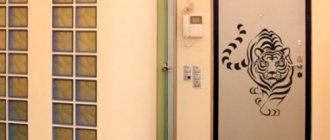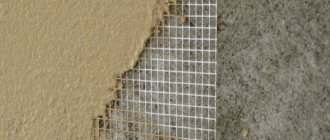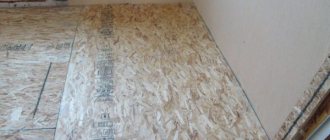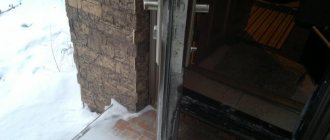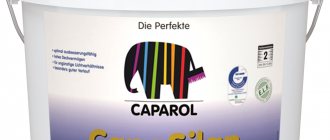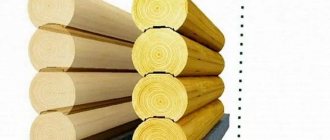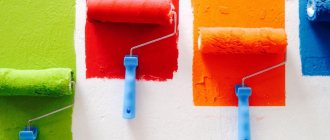Doors protect and decorate our homes, but their fate is not easy. They are regularly scratched, beaten and otherwise damaged. Unfortunately, this is almost impossible to avoid, since the entrance doors have to be opened and closed regularly, often by squeezing large, heavy objects through them, which can also severely damage the surface of the door leaf.
Apart from such serious damage as, for example, deep dents or scratches, the most common defect in the door leaf is deterioration of the paintwork.
Instructions for painting a metal door with your own hands
When starting painting, you need to follow the appropriate rules, otherwise the result will not be durable and you will soon have to repaint the door.
How to paint a metal entrance door
When you start work, remove all removable fittings (handles, peephole, number) and decorative elements. And cover those parts that cannot be removed with masking tape. It is best to remove the door itself and paint it in a horizontal position. To avoid staining the surface, place an oilcloth under it. Painting should start from top to bottom. This will help avoid leaks.
The next stage is surface preparation. If it was previously painted, remove the old layer. To do this, use a special remover that will dissolve the paint layer, a metal brush, or you can use a sanding machine. Apply a degreasing primer over the entire surface. However, if rust appears, it should also be carefully removed with sandpaper, a brush or acid. If there are any uneven spots or dents, smooth them out using automotive putty.
Preparatory work is needed to obtain the necessary adhesion of the metal to the paint, as well as for greater durability of the coating. If this is not done, the coating will quickly lose its protective properties, as a result of which the metal will be susceptible to damage.
Coloring rules
After preparation, you can start painting. The easiest way to paint is with a spray gun, but you can use a brush or roller. First paint over the horizontal parts and small details, and only then proceed to the vertical surface. Make sure that the layer is of uniform thickness.
Varnish or paint is applied to a metal surface in several layers. But the previous layer must dry well. At the same time, make sure that the color tone is uniform and there are no transitions or gaps.
How to paint a metal door on the street
When choosing a coating for a metal entrance door in a private home, pay attention to its durability and wear resistance. Hammer and powder coatings or alkyd enamel are best.
Selection of materials for painting
In principle, all paints for MDF are selected taking into account the composition of the material. And this is, first of all, a fine wood fraction, which means that paint solutions for wood are suitable for the job. But to obtain a truly high-quality coating, it is advisable to use special mixtures.
Polyurethane enamels
This material should be preferred for the following reasons:
- The coating is wear-resistant and can withstand exposure to household chemicals.
- The solution does not have an unpleasant odor, which makes it possible to carry out work in cramped home conditions.
- The mixture can be applied using a sprayer, roller and brush.
- Painting MDF with enamel is done independently; this procedure does not require professional skills.
Naturally, when choosing this material, they pay attention to the manufacturer. It should be a well-known brand that is sold in specialized stores. When purchasing a product from an unknown manufacturer, there is a high probability of getting a fake.
Advice! If it is not possible to select a polyurethane composition, then pay attention to alkyd enamels and paints (oil and acrylic).
Thus, the question of how to paint MDF panels is no longer a problem. But another dilemma arises - the surface needs additional protection, how can this be done?
Indeed, to increase resistance to mechanical stress and protect against chemical compounds, varnish is used. And for such work, a two-component polyurethane composition is especially suitable, which has all the desired parameters.
Nitropaint
Nitro paint is often used to paint steel entrance metal doors. Nitrocellulose enamels have a number of advantages: a wide range of colors, do not dry for long, low price. Immediately after coating, the metal surface has a beautiful glossy finish, but over time the color will fade. Although nitro paint protects the metal from corrosion, it does not last long and is not resistant to external factors.
Be careful when using nitro paint, because it can only be used in a non-residential, well-ventilated area, or better yet, outdoors. The toxicity of the coating will persist until it dries completely.
Restoration of a swollen surface
Often veneered doors have such a common defect as swelling. It is formed due to the fact that the sheets were placed incorrectly and poorly glued. Repairing the door in this case is simple. The main thing is to be patient.
Restoration of veneered doors should begin with the use of adhesives. In the place where the bubble has formed, we inject glue using a regular syringe. For good adhesion, you should press the veneer tightly with your finger and try to rub the glue over the entire area of the given space. This method allows you to restore the surface of the door literally in minutes.
The veneer was swollen on the doors. What else is effective? If this method is too complicated, it will be much easier to heat the iron and gently rub the area. Press on the surface carefully. You can pre-moisten the surface with a damp cloth to make the material more elastic.
Using hammer paint
The metal surface, coated with hammer paint, has an unusual and original appearance with a hammer effect. The roughness of the coating makes it possible to hide minor flaws in metal products.
To paint a metal entrance door with a hammer coating, no special surface preparation is required. The paint has excellent adhesion to metal. If applied correctly, it can last up to 25 years. In addition, due to its durability, protection of metal from corrosion, and comparative ease of use, it is gaining increasing popularity all over the world.
Wood painting
Painting a metal entrance door to match a wood structure requires a special approach. First, you will need to choose a special grater that will help imitate wood. Then paint in two shades: light and dark to imitate the type of wood.
After preparing the metal coating, you can begin painting. Start by applying a light shade. After complete drying, lightly sand, then apply coatings of a darker shade. Without waiting for it to dry, you need to carefully go over it with a rubber float, repeating the pattern of the tree. This will remove some of the dark tone, and the resulting pattern will resemble wood. When the second layer has dried, you need to coat the metal with varnish.
Repair of serious damage
If the damage is serious, restoration will necessarily include the installation of patches.
Repairing a veneer door is divided into several steps:
- The problem area must be cut out of a small section of the top layer. It is necessary to carefully remove this cut and see if others are needed.
- After this, take a piece of veneered material and apply it to the surface of the door. Before proceeding to the next step, you need to choose such a location for the patch so that the pattern of the entire canvas is not disturbed.
- The next stage of restoration of interior doors with veneer is cutting out patches. To do this, take a scalpel or sharp knife and cut out a certain shape of the material. In this case, experts advise making cuts across the texture of the canvas.
- The cut parts are placed in prepared places and glued securely.
- After this, you can treat the entire surface with a special veneer varnish.
Features of powder paint
Powder coating doors has a number of advantages:
- fire safety;
- high resistance to damage;
- high environmental safety;
- attractive appearance.
However, the cost of such a coating is quite high, and it is impossible to apply it at home. The powder is sprayed electrostatically and heated in special chambers with a temperature of 200°C. This is how the powder penetrates the metal structure. After cooling, apply varnish.
Entrance doors are subject to heavy loads due to frequent use and exposure to external factors. Protecting an apartment or house from uninvited guests, entrance doors are subject to mechanical damage, fading in the sun, loss of brightness from moisture and other reasons.
How to paint interior doors made of MDF
The door leaf often has to be changed during repairs - it does not fit into the new interior design. Painting interior doors made of MDF has its own technological nuances. A large assortment of varnishes and paints only complicates the choice. Four compositions on different bases can be recommended for work in residential premises. Due to the caustic fumes, a large percentage of the compositions are applicable only for outdoor use.
Can I paint or repaint the inside and outside myself?
Entrance doors in a house or country house lose their attractiveness over time, both inside and outside, so they need to be updated. The most popular for the interior and exterior of metal and other doors are classic primer-enamel and hammer paint.
The main thing is to follow safety precautions when painting - use protective equipment to prevent chemicals from getting on the skin, and keep children and animals away.
Tip: The most even coating can be achieved using a spray gun. If you don't have one, regular brushes and rollers will do.
Choosing the type of finish
When a person thinks about how to update an old door, the first problem is the choice of material. There are not many options for metal structures:
- Renew old doors by simply repainting them. It turns out quickly, not expensive, but it is far from exclusive;
- Restore an old door using laminated MDF panels or, as professionals say, “cards.” The step-by-step instructions are quite simple, but the price for such an MDF card is decent;
- Do-it-yourself restoration of old doors using homemade wooden overlays. Here the cost depends on the type of wood, but the finishing technique itself is not complicated;
- The royal option is considered to be the restoration of doors using the so-called carriage screed (quilted faux leather trim). It looks rich, but to make such doors with your own hands you will have to tinker a lot.
Three options for carriage screeds for entrance doors.
What kind of paint should I use: hammer paint or another?
In order for the door leaf to look beautiful for a long time, you need to know how to choose the right paint. Main methods:
- Acrylic paint. Advantages: durability, quick drying. This material is non-toxic because it is water-based.
- Automotive paint , which is best applied with a spray or aerosol can. This painting looks expensive and stylish.
- Nitroenamel. It looks good, gives the product shine, and protects against corrosion. The downside is that the material is sensitive to chemical and thermal effects and will last a relatively short time, so it is better to use nitro enamel when you need to save money.
- Alkyd enamel. Whatever color an iron or other door is painted, thanks to the alkyd resins in its composition, the enamel does not lose it, and also dries quickly and retains its properties for 4 years. However, such enamel is not repairable. To give the canvas its original appearance, you will have to completely remove the old material, then paint it again.
- Hammer. Mainly applicable for armored door blocks. It can give the surface roughness and achieve a tone similar to the iron of a hammer. These doors look very original.
- Powder. It is used more often to cover the entrance doors of luxury homes, as it is a luxury material and is characterized by high strength and durability.
However, it is impossible to independently finish metal surfaces with powder paint - special equipment is required. The product is painted electrostatically, then placed in a special chamber with a heating temperature of about 200 degrees. The polymer powder melts and penetrates the metal structure. - Epoxy. Used for painting technical and industrial premises, very practical, paints any metal.
- Graphite. Advantages: protection of metal from corrosion, resistance to temperature changes.
Advice The choice of paint should be based on its properties, ability to withstand adverse external factors and the type of room where the door leaf is located.
Possible defects
Restoration begins after determining the extent and type of damage. The defects of wooden doors of different designs may differ; to eliminate them, a suitable method is selected:
- Deformation of a multilayer door leaf. A curved product is almost impossible to close, or large gaps remain due to a loose fit to the frame. The defect is common for products made from several layers of wood. The reason is a violation of gluing technology, poor-quality material or intense exposure to moisture. Minor curvature is compensated by adjusting the frame. In case of severe bending, replace the top layer of sheathing to relieve stress.
- Peeling of covering sheets from the frame. The defect occurs as a result of the manufacturer using low-quality glue or when the recommended operating conditions are violated. It can be restored by re-gluing and then keeping the product under pressure. However, the solid frame and covering sheets react differently to moisture and temperature changes. When peeling, the decorative coating often cracks or breaks in pieces. Small cracks are hidden with putty. If the peeled sheet cannot be restored, it is replaced.
- Loosening of the glued door frame. The result of the defect is loose closure, as well as the formation of cracks. It can be assumed that the product itself is bent. To make the right decision, both structural elements are inspected. If the problem is in the box, it is strengthened by removing the trim.
- Door leaf skewed. Diagnosis begins with inspection of the loops. If the door is too loose, it may not close. If a misalignment is detected, which is often found on a frame where the elements are connected by a notch, leveling is done using wedges. Grooves are cut out in the corners of the structure and filled with glue. Wedges sharpened at an angle of 10° are driven in with a hammer until the frame is completely level.
- A slight increase in the gaps between the leaf and the door frame is likewise a defect. Heat escapes from the house through a loosely fitting sash, reducing the quality of sound insulation. The problem with small gaps is solved by gluing seals.
Don't miss: Tool for inserting locks into interior doors: a set of tools for installing door locks
How to do it yourself?
Having determined the type of coloring composition, we begin work, which conventionally consists of three stages:
- Selection of all necessary materials.
- Basic surface preparation.
- Coloring.
Let's talk about each of them in more detail.
Materials and tools
To work you will need:
- putty or primer to remove deep scratches;
- sandpaper or wire brush to prepare the canvas for painting;
- container with water, detergent, cotton rags;
- masking tape, protective film or newspapers to protect surfaces;
- dye;
- acrylic varnish for finishing coat.
To save time, use an aerosol, then brushes and rollers may not be needed. Do not forget about means of protection against paint getting on your skin and mucous membranes - rubber gloves, a respirator.
What is needed to prepare a metal (iron) or wooden surface?
The essence of the preparation is to achieve good adhesion of the metal to the paint and give the coating durability.
- First, remove all decorative elements, removable fittings - handles, number, peephole. Seal parts that cannot be removed with masking tape. It is better to remove the canvas itself from its hinges and paint it in a horizontal position.
- To remove the old layer of paint, use a special remover or remove the remains with sandpaper, a sanding machine or a wire brush. The surface is degreased and covered with a primer.
Attention: To seal cracks and irregularities, it is better to use automotive putty.
Removing minor abrasions and scratches
If you find small defects on your door, you certainly shouldn’t be upset. Veneer restoration in case of minor damage such as chips and scratches is carried out using:
Applying an additional layer of wax coating.
- It is necessary to clean up minor defects. It’s true that you need to work with tools and materials as carefully as possible. In pursuit of eliminating small cracks and abrasions, you can damage the canvas. It happens that the owners apply the “skin” too hard and the varnish coating becomes unpresentable.
- Then thoroughly clean the canvas from dust and dirt.
- Each section of the entire door should be thoroughly degreased. This will allow you to apply the wax efficiently and it will last long enough.
- Heat the wax and carefully pour it deep into the scratches. And if everything is done correctly, the result will be stunning. Defects will disappear without a trace.
Using a wax pencil.
Wax pencil is also suitable for resurfacing. You can refresh veneer doors with a special pencil only if you use very little material. You need to take a small piece of wax rod and knead it in your hand for a while. When heated, it will take on the desired consistency and can be rubbed into the surface of the product with your finger. A rag will help remove excess.
